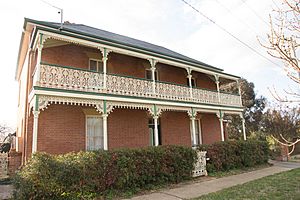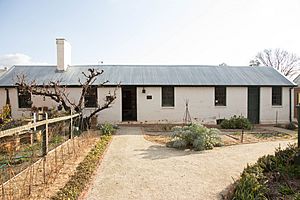Old Government Cottages Group, Bathurst facts for kids
Quick facts for kids Old Government Cottages |
|
|---|---|

Macquarie House, located at 1 George Street
|
|
| Location | 16 Stanley Street, Bathurst, Bathurst Region, New South Wales, Australia |
| Built | 1837–1860 |
| Architectural style(s) | Victorian Filigree (1 George Street) |
| Owner | Bathurst Regional Council |
| Official name: Old Government Cottages Group; 'Old Government House'; Macquarie House; Miss Falloon's cottage; John Ford's house | |
| Type | State heritage (complex / group) |
| Designated | 21 February 2003 |
| Reference no. | 1659 |
| Type | Government House |
| Category | Government and Administration |
| Lua error in Module:Location_map at line 420: attempt to index field 'wikibase' (a nil value). | |
The Old Government Cottages Group includes two historic houses in Bathurst, Australia. These houses are located at 16 Stanley Street and 1 George Street. They were built between 1837 and 1860. People also know them as 'Old Government House', Macquarie House, Miss Falloon's cottage, and John Ford's house. The Bathurst Regional Council now owns these important buildings. They were added to the New South Wales State Heritage Register on February 21, 2003.
Contents
A Look Back: History of the Cottages
First People and Early Settlement
Long before Europeans arrived, Aboriginal people lived in the Blue Mountains area. The Wiradjuri people lived in the Bathurst region. They moved around in small groups, following the seasons. They found food along the Macquarie River.
In 1813, the first Europeans crossed the Blue Mountains. This led to new settlements. Lachlan Macquarie, who was the Governor, officially named Bathurst a town on May 7, 1815. He named it after Lord Bathurst. Bathurst is special because it is Australia's oldest inland town.
How Bathurst Grew
Governor Macquarie chose the spot for Bathurst in 1815. Convicts, supervised by William Cox, built the road to get there. Macquarie wanted to control how many people settled in the rich Bathurst Plains. He gave out only a few land grants at first.
In 1818, more land was given out. Ten men received farms and town lots. The government farm, which was not very successful, closed in 1828.
In 1825, Governor Darling arrived in Sydney. He made big changes to how the colony was run. The town of Bathurst was officially designed in 1830 by Thomas Mitchell. The first land sales happened in 1831.
In 1832, Governor Sir Richard Bourke visited Bathurst. He asked for the town to be opened quickly. The streets were laid out in September 1833. It is thought that Major Mitchell named the streets. George Street was named after King George III.
The Old Government Cottages Group
The land where these buildings stand was once a government area. It was sold in 1847 to James William Bligh. Some people believe an older building, known as "Government cottage," was already there. This would mean it was built when the land was still controlled by the government. However, there is no clear proof of this. An old brick found at 1 George Street is dated "AD 1827." This might be from an earlier building or when the cottage was built.
James William Bligh sold the land to Miss Falloon. She ran a small school from her home. She might have built or improved the cottage at 16 Stanley Street. In 1857, she sold the property to Mr. John Ford. He was a banker and ran coach services.
John Ford built the two-story house in 1859 or 1860. The cottage at the back likely served as the kitchen and living area for servants. By 1862, he was living in Bathurst.
Later, from 1884 to 1887, Macquarie House (1 George Street) was a college for young ladies. It was one of several schools in Bathurst at the time.
John Ford Junior passed away in 1890. The house then changed hands a few times. In 1918, an advertisement described the property. It mentioned a "fine two storied brick residence" and the "old Government House."
In 1964, the Bathurst City Council bought 1 George Street. They gave it to the Bathurst Historical Society. It was believed that the single-story wing behind 1 George Street was the only building authorized by Governor Macquarie.
In 1972, major restoration work began on the cottage. It was furnished to look like it did in the past. In 1989, the two houses were separated into different properties: 16 Stanley Street and 1 George Street.
In 2015, a "period" garden was planted. It used plants from the colonial era. This project was part of Bathurst's 200th birthday celebrations.
What the Cottages Look Like
The Old Government Cottages Group includes 1 George Street (Macquarie House) and 16 Stanley Street (Old Government House). Both buildings are in a special conservation area in Bathurst.
The cottage at 16 Stanley Street might be older than 1 George Street. For most of their history, they were part of one large house. The cottage served as the kitchen and staff area for the main house at 1 George Street.
No. 1 George Street is a two-story brick building. It has a hipped roof made of corrugated iron. A wide verandah stretches across the front of the house. It has fancy iron columns, lace balustrades, and decorative brackets. The front of the house looks balanced, except for a garage added in 2000.
The cottage at 16 Stanley Street is a single-story brick building. It has a gable-ended roof, now covered in shingles. This cottage faces Stanley Street. It looks older than 1 George Street. It has several windows and wooden doors. Inside, there are four rooms, with three connected.
As of July 2015, 1 George Street was in excellent condition. 16 Stanley Street was in fair condition. The group still shows why it is important. The original fence is mostly gone, but there are plans to replace it.
Why These Cottages Are Important
The Old Government Cottages Group is one of the oldest brick buildings west of the Macquarie River. It is on the original government land. These buildings are important because of their connection to early Bathurst figures like James William Bligh.
No. 16 Stanley Street is the older building. It might have been built as early as 1837. No. 1 George Street (Macquarie House) is also important for its beautiful design. Its fancy ironwork on the veranda shows the Victorian filigree style.
These buildings are also a landmark in Bathurst. They are on a corner overlooking the Macquarie River. Their old-fashioned style adds to the historic feel of this part of town.
The Old Government Cottages were added to the New South Wales State Heritage Register on February 21, 2003, because they meet several important standards:
- They show the history of New South Wales.
The group is important because it is linked to the founding of Bathurst. Bathurst was Australia's first inland town. These cottages are some of the oldest buildings west of the Macquarie River.
- They are connected to important people.
The cottages have strong links to people like John Ford, James William Bligh, and Miss Keyes.
- They show great design and beauty.
The group is important for its location overlooking the Macquarie River. It helps create the colonial look of old Bathurst.
- They are valued by the community.
The cottages are important to the local community. They serve as a museum of local history. They help people connect with the town's beginnings.
- They can teach us more about history.
The group is a good example of old colonial brick building in New South Wales. There might also be old items buried on the site that could teach us more.
- They are rare examples of history.
The Old Government Cottages Group, especially 16 Stanley Street, is a rare example of old colonial brick building west of the Macquarie River.
- They represent a type of historic place.
The Old Government Cottages Group, especially 1 George Street, shows how homes changed over time in the Victorian era.
Images for kids




